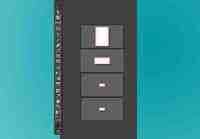How to set up automatic page numbering in Adobe InDesign — Paper + Oats
Make InDesign Add Pages Automatically As You Type
Make InDesign Add Pages Automatically As You Type

Many new users, when sitting down in front of InDesign for the first time, open a new document and start typing — as though InDesign were a word processor. Of course, they quickly learn they need both the Type tool and a text frame. But one thing still bugs them: Why, when you fill that first frame with text, won’t InDesign add a new page and a new text frame for you?! It seems like the logical thing to do. So logical, in fact, that Adobe added this feature… but unfortunately they made it a little tricky to find or figure out.
The feature is called Smart Text Reflow and it showed up back in CS4, in the Type pane of the Preferences dialog box:
Here’s the thing: by default, it only works when you are working on a text frame that is on a master page. That is, you:
put a text frame on the master page (or use the Master Text Frame or Primary Text Frame feature in the New dialog box) override that frame on a document page by either placing text into it or command-shift-clicking it (or ctrl-shift-click on windows) type in it or edit the text so that the frame oversets pause one or two seconds so that InDesign notices that the frame is overset
At that point, you suddenly get a new page, with a new text frame, and the frames are automatically threaded together. (We call it “threading” in InDesign, not “linking,” because “linking” has to do with the Links panel.)
Any Text Frame
[Note that in CS6 the feature in Preferences is called “Limit to Primary Text Frames,” but as far as I can tell, it’s just like CS5 and earlier — it’s any text frame on the master page, not just primary frames.]
You can make Smart Text Reflow work on any text frame by turning off the limitation checkbox in the Preferences dialog box. However, in that case, you still won’t get it on every frame… it will only work for stories that are in frames that are already threaded across two or more pages! In other words, it won’t apply to any frame or story that is only on a single page.
And, because you’re not using a text frame on the master page, InDesign doesn’t know how big to make the new frame… so it makes a new page and fills the page (from margin to margin) with a new frame.
Note: Personally, I wish InDesign allowed us to specify auto-reflow on a frame-by-frame basis. That’s why I specced it that way in the Blatner Tools suite of plug-ins. With BT, you can simply select any frame on your page and choose Object > Use AutoPage. This add-on feature also ensures that the new text frame is the same size and position as the original (instead of filling the whole page).
How to Create Multiple Page Sizes in One Adobe InDesign File
Adobe InDesign is a remarkable tool for many print and marketing design projects. It makes it extremely easy to work on publications, move design elements around, and export out for your printer. However, what happens if your project requires different sizes for each item?

Letterhead is a great example of this. When you design letterhead you have many components from the letter to envelopes and business cards. In earlier versions of InDesign you would have to create a separate file for each, but with InDesign, you can use the handy Page Tool to resize each page within one document. This keeps everything in one easy to access document and dramatically improves your workflow. Let's take a look at the process!
This is one of the many things you'll pick up in my course, Advanced Print Options.
1. The Page Tool
You'll find the Page Tool under the Direct Selection arrow in the Toolbar. When you select it, you'll notice the Properties Bar at the top changes to reveal X and Y coordinate options as well as Width and Height options. You'll also notice options very similar to the Document Window that appears when you create a new document. This is where you'll apply all your page size specs. Let's see it in action!
2. Set Up You First Document
Step 1
The first item I create in my letterhead workflow is the main letter. The size of this document is a classic A4 size. Open InDesign and select File > New Document to create your first item. Set Intent to Print and Number of Pages to 1 (we'll add more later). Deselect Facing Pages. Under Page Size select A4. Set the Bleed to .125 in on all 4 sides.
Bleed Tip: Even if you don't think you'll design your letterhead with a full bleed, it's best to set it up this way from the beginning. It's easier to design with a bleed and not use it then add it in later.
Click OK.
No you have your first letterhead document ready to go. Instead of saving and adding another InDesign document to the mix, we're going to add the pages for the envelope next right in the same document.
Step 2
We're only going to design the front of the envelope, so we need to add one page. Duplicate the page you just created by clicking and dragging the page from the Pages panel to the New Page icon just to the left of the trash can icon.
Now that you have the new page, it's time to resize it with the Page Tool.
Step 3
Make sure the second page is active in the Pages panel and the Select the Page Tool. You'll notice the page is selected with new anchors around the edges. This allows you to resize by clicking and dragging any one of the anchors. We want to be more precise, however, and will use the properties at the top instead. Change the Width to 9.5 in and the Height to 4.125 in. This is the standard No. 9 envelope for letters.
You'll see the document transform to this new size. However, did it affect the letter page we created earlier? Scroll up and notice the original page remains the same A4 size we already set. Cool!
Step 4
Now repeat Step 3 for the business cards. This time you'll create two duplicate pages. One for the front and one for the back of the business card. Instead of inputting the width and height, select the Custom drop down and go to US Business Card. This will format your page to the standard 3.5 x 2 in business card size. If you have a different business card size, you can input it exactly like you did for the envelope in Step 3.
Conclusion
You end up with an InDesign document that has four different sized pages. One for the letter, one for the envelope and two for the business card. If you Zoom Out, you'll notice that the page sizes are different in the Workspace as well as the Pages Panel. This will help you see what page is what in your letterhead workflow.
There are many other uses for this handy feature in InDesign. To see more advanced techniques including how to design letterhead and save out a PDF with multiple page sizes, head on over to my Advanced Print Options Course! You'll also discover how to work with Text on a Path and Advanced Folds, and apply these techniques to two design projects.
How to set up automatic page numbering in Adobe InDesign — Paper + Oats
The best place to put a page number is on a parent page (formerly master page). A parent page is like a mini-template that is great for any repeated content that you want to show up on every page like headers, footers, backgrounds, and especially page numbers.
I’ll open the Pages fly-out menu first – if you don’t see that option on your screen, you can go to Windows > Pages.
At the top of this window it lists out your parent pages, and below this line is all the actual pages in your document. Double click on your parent page to make changes to it.
On the parent page, I’ll draw a text box, but don’t type anything in it yet. Instead, with the cursor flashing, go to Type > Insert Special Characters > Marker > Current Page Number.
This will place an A as a placeholder here on your parent page since this isn’t an actual page in your document.
I’m going to make the font size obnoxiously large just so you can see it clearly for this tutorial.
So click back your first page in your document, and as long as your parent page is applied to a page, that page number will show up. And as we scroll through the rest of our pages, the page numbers are automatically populated.
The best part about this tool? If you add more pages or rearrange any pages, it will automatically renumber your pages for you, so you never have to worry about them getting mixed up. How cool is that?!
Want to learn more about InDesign? Check this out